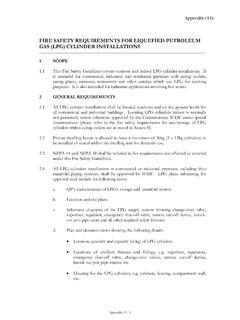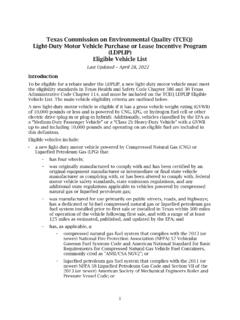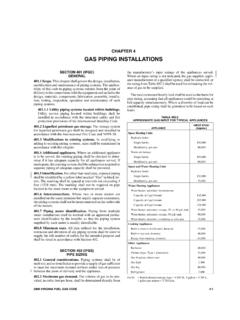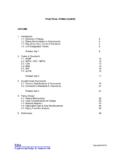Transcription of 2011-2014 Ford E-Series and F-Series Products
1 DIAGNOSTIC MANUALP-01B101-AF2011-2014 Ford E-Series and F-Series ProductsLiquid Propane Autogas Fuel System (3rd Generation)Includes:E-150/E-250/E-350 Cargo Van/WagonE-150/E-250/E-350 Extended Range Cargo Van/WagonE-450 Custom BodyF-250/F-350/F-450/F-550/F-650F-53/F- 59 Revision History-AAInitial Release2/2013-ABRevised5/2013-ACRevised7 /2013-ADRevised11/2013-AERevised3/2014-A FRevised8/2014 TABLE OF CONTENTSPage iiiSAFETY INFORMATION ..2 Alert Messages ..2 Installation, Garaging and Training ..3 Purging and Venting (Tanks and Lines) ..3 DIAGNOSTIC TROUBLE CODES ..5 About Diagnostic Trouble Codes ..5 System and Diagnostic Terminology ..5 Diagnostic Trouble code List ..6 Calibration Release OBD Summary Chart.
2 7 Calibration Release OBD Summary Chart ..8 Calibration Release OBD Summary Chart ..9 Flow Control Solenoid ..10 Bleed Solenoid ..10 Tank Solenoid ..11 Fuel Rail Pressure Control Module Supply Solenoid and Wiring ..12 SRM, CAN Bus Circuit Wiring ..13 Fuel System ..13 Heated Exhaust Gas Oxygen Sensor ..14 Electronic Fuel Pump Relay (A/B) .. 15 Integrated Pressure Temperature Sensor ..16 Fuel Level Sender ..18 DIAGNOSTIC TESTS AND PROCEDURES ..21 General Information ..21No Fill ..22 Slow Fill ..24 Over Fill ..26 Engine Does Not Crank ..27 Engine Cranks, No Start ..28 Engine Stumble, Stall, Rough Idle ..30 Excess Flow Valve Check ..31 Maximum Pressure Check ..32 Supply Solenoid Check.
3 32 Fuel System Fails to Bleed ..34 Fuel Pressure Drop ..35 Fuel Level Indication Check ..36 Tank Solenoid Electrical Check ..37 Fuel Rail Pressure Control Module Electrical Check ..39 Integrated Pressure Temperature Sensor Electrical Check ..41 Fuel Pump Electrical Test ..42 Fuel Pump Control Module Electrical Continuity Test ..44 Smart Relay Module Electrical Test ..46 Fuel Level Sender Electrical Check ..48 Fuel Level Interface Module Electrical Test ..50 Manual Solenoid Activation Procedure ..51 WIRING DIAGRAMS AND ELECTRICAL SCHEMATICS ..52E-150/250/350 Wiring Harnesses and Connector Layout ..53E-150/250/350 Extended Range Wiring Harnesses and Connector Layout ..54E-450 Custom Body Wiring Harnesses and Connector Layout.
4 55 Page ivTABLE OF CONTENTSF-250/350 Pickup, In-Bed Tank Wiring Harnesses and Connector Layout ..56F-650 Chassis Cab Wiring Harness and Connector Layout ..57F-450/550 Roush Wiring Harness .. 58F-650 Chassis Cab, Roush Wiring Harnesses ..59F-53/59 Roush Wiring Harnesses ..60E-Series, Extended Range and E-450 Electrical Schematic Underhood Harness ..61E-Series, Extended Range and E-450 Electrical Schematic CAN Bus Harness ..62E-Series, Extended Range and E-450 Electrical Schematic Rear Frame Harness ..63E-Series, Extended Range and E-450 Electrical Schematic In-Tank Harness ..64E-Series, Extended Range and E-450 Electrical Schematic Solenoid Harness ..65E-450 Stripped Chassis CAN Harness.
5 66F-250/350 Pickup, CAN Bus Jumper Harness Electrical Schematic ..67F-250/350 Pickup, F-450/550 and F-650, Tank Solenoid Harness Electrical Schematic ..68F-250/350 Pickup, In-Bed Fuel Tank Jumper Harness Electrical Schematic ..69F-250/350 Pickup, FTPT Jumper Harness Electrical Harness ..70F-650 CAN Harness ..71F-650 Fuel Tank Jumper Harness ..72F-650 Underhood Harness Electrical Schematic ..73F-53/59 CAN Harness ..74F-53/59/250/350/450 Rear Frame Harness Electrical Schematic ..75F-53/59/250/350/450 Underhood Harness Electrical Schematic..76F-53/59/450 Fuel Tank Jumper Harness Electrical Schematic ..77 INTRODUCTIONPage 1 INTRODUCTIONPage 2 INTRODUCTIONSAFETY INFORMATIONThe national fire protection association ( nfpa ) publishes a code book of rules that apply to the storage, handling, transportation and use of liquefied petroleum gas (LP-Gas or LPG).
6 The book is known as nfpa 58. It is revised as necessary and published every other year. This code is adopted as law in virtually every political subdivision in the United States. Check with your local authorities for regulations applicable to liquid MessagesThe following alert messages may appear from time to time in appropriate places in this manual. Ensure that all personnel read and adhere to these alert propane is nontoxic, nonpoisonous, has the lowest flammability range of any alternative fuel and dissipates quickly when released into the atmosphere, propane vapor is heavier than air and seeks the lowest point. When the ratio of propane to air is between and , propane will burn in the presence of an ignition source at 940 F (504 C) or hotter.
7 Keep away from heat, sparks, flames, static electricity or other sources of ignition. Failure to heed this danger may result in severe personal injury or fuel supply lines remain pressurized after engine shutdown. Keep away from heat, sparks, flames, static electricity or other sources of ignition. Do NOT enter storage areas or confined space unless they are adequately ventilated. Failure to heed this danger may result in severe personal injury or NOT carry lighted smoking materials or smoke while working on fuel system components. Failure to heed this danger could result in severe personal injury or the battery ground at the battery to ensure that the vehicle electrical system has no current.
8 Failure to heed this danger could result in severe personal injury or is heavier than air and seeks the lowest available level when released to the atmosphere. Keep heat, sparks, flames, static electricity or other sources of ignition out of the area when venting or purging the fuel lines or tank. Failure to heed this danger can result in severe personal injury or property working with, or around, fuel systems should be properly trained to utilize extreme care and caution at all times. Failure to exercise extreme caution and care may lead to serious accidents which can result in property damage, personal injury and/or propane is cold. The temperature of propane in its liquid state at atmospheric pressure is 44 F ( 42 C).
9 Wear eye and ear protection during venting and repair operations. Keep moisture away from the valves. Failure to heed this warning can result in personal 3 Installation, Garaging and TrainingChapter 11 of nfpa 58 applies to engine fuel systems using LP-Gas in internal combustion engines, including containers, container appurtenances, carburetion equipment, piping, hose and fittings and their installation. Additionally, this chapter applies to garaging of vehicles and to the training of specifies that each person engaged in installing, repairing, filling or otherwise servicing an LP-Gas engine fuel system shall be trained. Contact the Propane Education and Research Council to learn more about their CETP E-Learning computer-based training program: or and Venting (Tanks and Lines)Venting of LP-Gas to the atmosphere is covered by paragraphs , General, and , Purging of nfpa 58, 2008 edition.
10 Refer to nfpa 58, Local Codes and Proper Training for specific information relating to safe venting of 4 TROUBLESHOOTINGTROUBLESHOOTINGTROUBLESHO OTINGPage 5 DIAGNOSTIC TROUBLE CODESA bout Diagnostic Trouble CodesAll diagnostic trouble codes (DTCs) known to be affected by the liquid propane autogas (LPA) system are covered in this manual. For all other DTCs, refer to the Ford Powertrain Control/Emissions Diagnosis Service Manual at and Diagnostic TerminologyAcronym or AbbreviationDescriptionBSBleed SolenoidCANC ontroller Area NetworkDTCD iagnostic Trouble CodeEFPRE lectronic Fuel Pump RelayERFSE lectronic Returnless Fuel SystemEVAPE vaporativeFCSFlow Control SolenoidFLIMFuel Level Interface ModuleFLSFuel Level SenderFPFuel PumpFPCMFuel Pump Control ModuleFRPFuel Rail PressureFRPCMFuel Rail Pressure Control ModuleFTSFuel Temperature SensorGRDG roundHEGOH eated Exhaust Gas OxygenICInstrument ClusterIPTSI ntegrated Pressure Temperature SensorKOEOKey On Engine OffKOERKey On Engine RunningLPAL iquid Propane AutogasMAFMass Air FlowOEMO riginal Equipment






